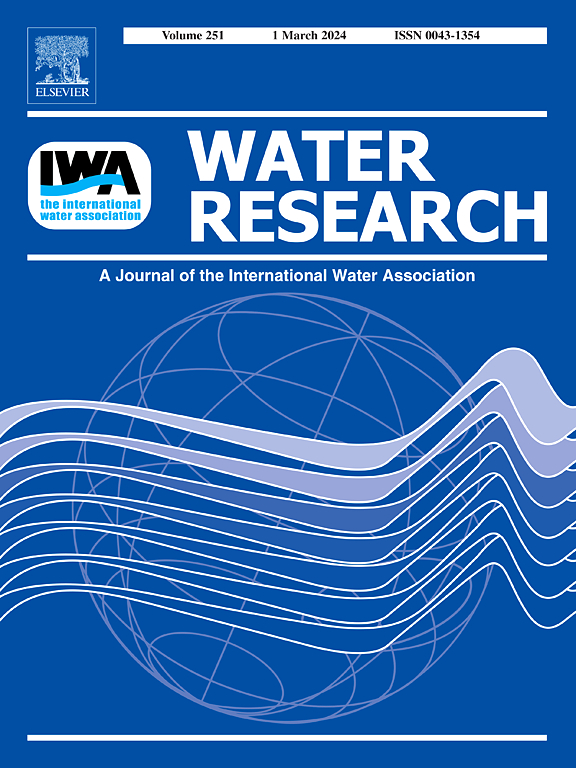Quantifying the Fate of Biogenic Elements in Mangrove Aquifers: Insights from Reactive Transport Modeling under Saltwater-Freshwater Mixing
IF 11.4
1区 环境科学与生态学
Q1 ENGINEERING, ENVIRONMENTAL
引用次数: 0
Abstract
Saltwater-freshwater mixing in mangrove wetlands drives complex biogeochemical processes that regulate the cycling and transformation of key elements. Yet, the detailed quantification of biogenic element cycling and transformations under saltwater-freshwater interactions remains insufficiently explored. This study developed a field-scale reactive transport model, constrained by multi-level monitoring and hydrochemical data, to investigate the migration, transformation, and fluxes of biogenic elements (C, N, S, Fe) in the Dongzhai Harbor mangrove wetland aquifer. The results reveal that freshwater-saltwater mixing and groundwater discharge enrich NH4+ and HCO3−, while elevated sedimentary iron content primarily reflects Fe²⁺ accumulation in groundwater. Heterotrophic reactions, including aerobic respiration, denitrification, and nitrification, dominate in high-flow regions, while iron and sulfate reduction occur across aquifer layers, influenced by DOC availability and transport dynamics. Low molecular weight DOC entering the aquifer originates primarily from oceanic inputs and sedimentary organic matter degradation (44.8%), with a minor contribution from terrestrial groundwater. Of this, 71.2% undergoes microbial reactions, significantly supporting nitrate removal (1.24 × 106 mol/year) while producing HCO3− and NH4+. The aquifer is estimated to produce 2.37 × 106 mol of DOC annually. Simulations demonstrate that aquaculture wastewater, enriched in DOC, ammonium, and nitrate, enhances solute inflow and reaction activity, increasing DOC and ammonium discharge to surface waters, despite nitrate removal rates remaining high (up to 83%). Changes in vertical permeability, related to mangrove root systems and benthic organisms, further influence nutrient cycling. Increased permeability promotes solute exchange and nitrate removal but reduces efficiency, whereas decreased permeability reduces nitrate removal but enhances its efficiency. These findings underscore the critical role of mangrove wetlands in regulating nutrient cycles and maintaining ecological stability, offering insights to support their sustainable management.求助全文
约1分钟内获得全文
求助全文
来源期刊

Water Research
环境科学-工程:环境
CiteScore
20.80
自引率
9.40%
发文量
1307
审稿时长
38 days
期刊介绍:
Water Research, along with its open access companion journal Water Research X, serves as a platform for publishing original research papers covering various aspects of the science and technology related to the anthropogenic water cycle, water quality, and its management worldwide. The audience targeted by the journal comprises biologists, chemical engineers, chemists, civil engineers, environmental engineers, limnologists, and microbiologists. The scope of the journal include:
•Treatment processes for water and wastewaters (municipal, agricultural, industrial, and on-site treatment), including resource recovery and residuals management;
•Urban hydrology including sewer systems, stormwater management, and green infrastructure;
•Drinking water treatment and distribution;
•Potable and non-potable water reuse;
•Sanitation, public health, and risk assessment;
•Anaerobic digestion, solid and hazardous waste management, including source characterization and the effects and control of leachates and gaseous emissions;
•Contaminants (chemical, microbial, anthropogenic particles such as nanoparticles or microplastics) and related water quality sensing, monitoring, fate, and assessment;
•Anthropogenic impacts on inland, tidal, coastal and urban waters, focusing on surface and ground waters, and point and non-point sources of pollution;
•Environmental restoration, linked to surface water, groundwater and groundwater remediation;
•Analysis of the interfaces between sediments and water, and between water and atmosphere, focusing specifically on anthropogenic impacts;
•Mathematical modelling, systems analysis, machine learning, and beneficial use of big data related to the anthropogenic water cycle;
•Socio-economic, policy, and regulations studies.
 求助内容:
求助内容: 应助结果提醒方式:
应助结果提醒方式:


